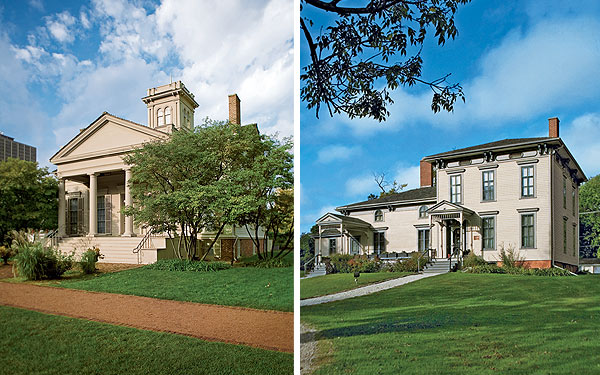
Since 1836, the peripatetic Henry B. Clarke House (left) has settled in at three different addresses. The Noble-Seymour-Crippen House (right) comprises the original 1833 farmhouse on the south (far left) and the two-story 1868 Italianate addition on the north.
The AP had a brief yesterday about the Clarke House’s impending 175th birthday. It’s an august age for a house, dating to before the city’s 1837 incorporation. But is it, as the brief claims, the oldest? It’s not quite that simple, as Geoffrey Johnson pointed out in his 2007 piece, "Battle of the Ages."
The Noble-Seymour-Crippen house in Norwood Park is unquestionably older, but it comes down to a philosophical point: what do you mean by "the oldest house in Chicago"?
At the most basic level, there would appear to be no contest. Mark Noble, an English immigrant, built his farmhouse in 1833 (today the house is at 5624 North Newark Avenue). Henry B. Clarke, who had traveled to Illinois from New York State, didn’t begin work on his house (in what would today be the 1600 block of South Michigan Avenue) until 1836, three years later. So how can there be any dispute?
Members of the Clarke camp base their claim on several things. Neither house, when built, was within the limits of the town of Chicago, but the Clarke property became part of the city when it was incorporated in 1837. Chicago did not annex the village of Norwood Park until 1893. That 56-year difference is crucial—"I feel we got there first," says Maldonado—as are Clarke’s and Noble’s motives in building their homes. The rurally inclined Noble, says Maldonado, came to Illinois to establish a 150-acre farm. "The Clarkes were pioneers who had come here to help establish a city," he says.
If you look at the pictures, you might think that the Noble-Seymour-Crippen house sure doesn’t look like a rural 1830s farm, and you’d be right: the Italianate addition was added later on. But as Johnson points out in the article, the Clarke House is now on its third location in the city—it was moved in 1872 when its owners got spooked by the Chicago fire, and after the City of Chicago took ownership it was moved to the Prairie Avenue Historic District, because why not, it was already moved once.
Here’s a video, with handy tips should your bungalow or condo building need to escape the next fire. At the very least, be sure to check out the video at 14 minutes, where you’ll be treated to a surreal image of the Clarke House crossing the Stevenson.
Clarke House Move from Chicago magazine on Vimeo.
Photography: Nathan Kirkman



Comments are closed.